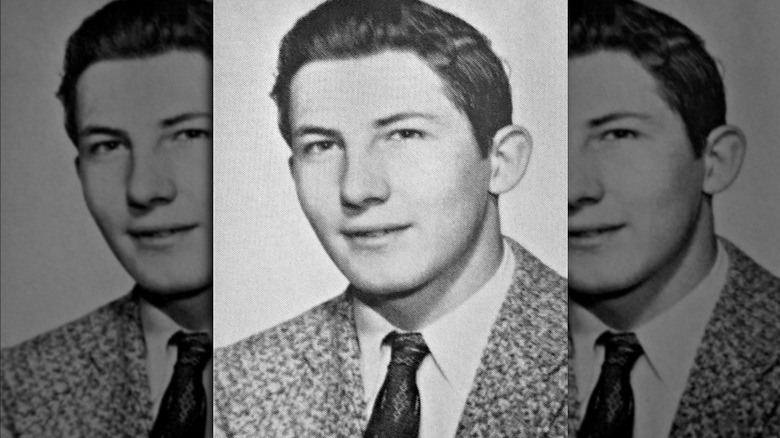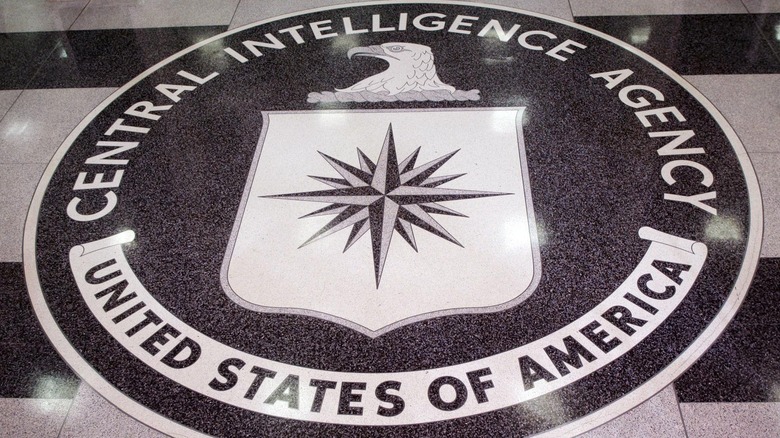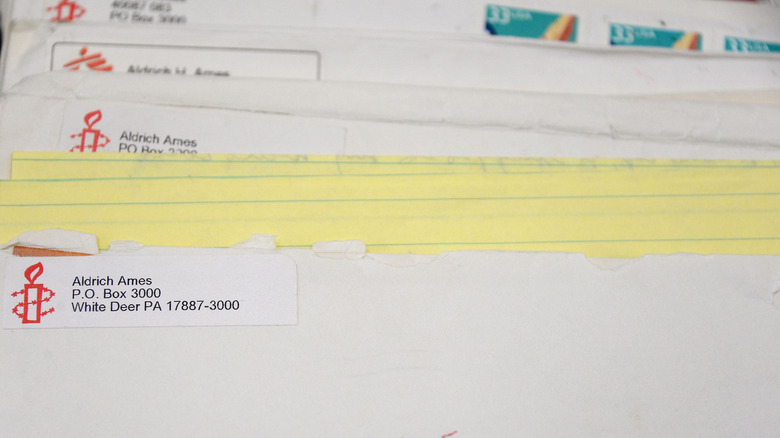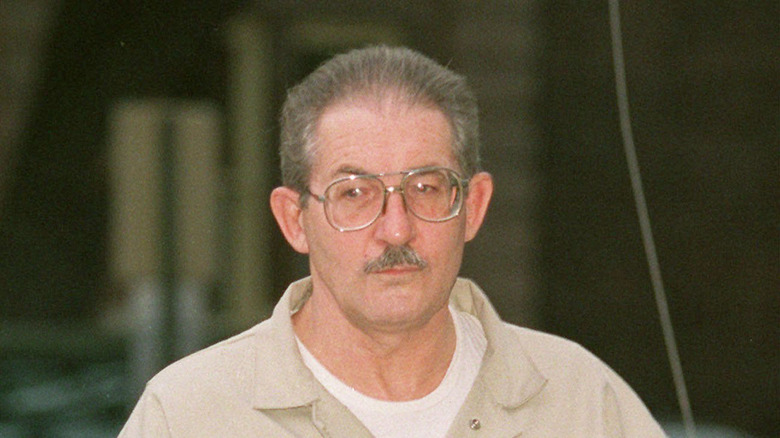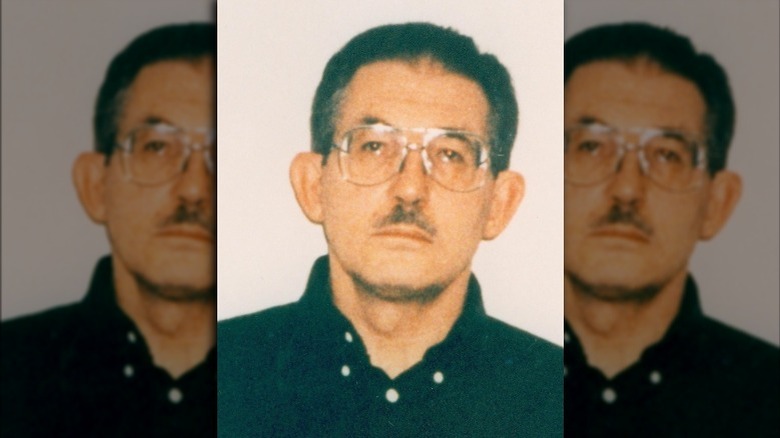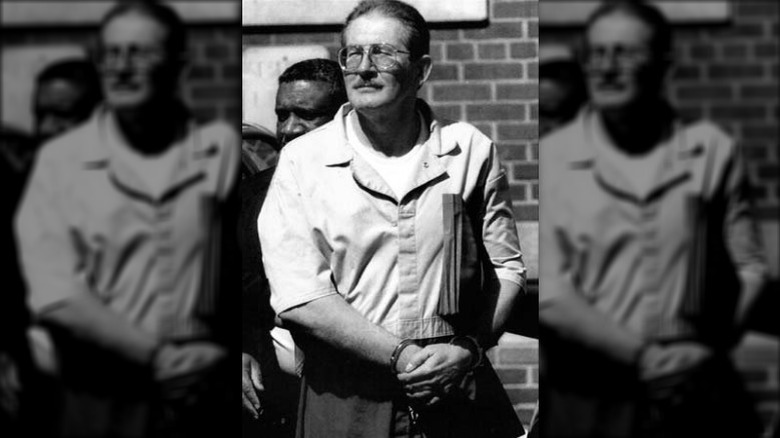How One Of The Worst Moles In CIA History Was Caught
By most accounts, Aldrich Ames wasn't the most remarkable man in the CIA. His work wasn't exceptional, and for most of his career he was just another person in the CIA office noticeably struggling with alcoholism. But in the end, it wasn't alcohol that was Ames' downfall. It was money.
Ames' financial problems led to him selling top secret information to Soviet agents during the end of the 20th century, to the point where he ended up making over $4 million as a result. And the information that he sold led to numerous agents being compromised, some of whom didn't make it out with their lives. But even though Ames is one of three known moles in the history of U.S. intelligence, some suggest that he may not have been the only one responsible for compromising agents in the 1980s.
Ames wasn't the best mole either. His suspicious behavior registered with people numerous times, and while it's not that hard to fool a polygraph test, Ames wasn't even great at that. Still, it took several years for anyone to dedicate themselves to figuring out what was going on. But once they did, it was only a matter of time before Aldrich Ames was arrested. Here's how one of the worst moles in CIA history was caught.
The early life of Aldrich Ames
Aldrich Hazen "Rick" Ames was born on May 26, 1941 in Rivers Falls, Wisconsin. He was the oldest of three children and initially both of his parents worked as teachers. His mother, Rachel, taught high school English while his father, Carleton, taught at River Falls State Teachers College. But when Carleton started working for the CIA's Directorate of Operations in 1952, the family moved to northern Virginia, writes The Famous People. According to the Senate Select Committee on Intelligence, although Carleton worked for the CIA until his retirement in 1967, government records show that Carleton "had a serious alcohol dependency" and was put on six-month probation after his only overseas tour.
Aldrich had accompanied his family during that overseas tour, and while he was in high school, he spent his summer working as a "low-ranking (GS-3) records analyst for the CIA." After graduation, he went to attend the University of Chicago and worked odd jobs with the CIA over the summers, but eventually, due to failing grades, he returned back to Virginia. There, Aldrich once again got a full-time job with the CIA in 1962, this time as a GS-4 clerk typist, which was basically the same job he'd done during his high school summers.
In March 1962, Aldrich took a polygraph examination, during which the polygraph examiner noted that Aldrich was "not sparkling, but a friendly, direct type." By May, Aldrich had been cleared for employment with the CIA.
Assigning Aldrich Ames to Ankara
Aldrich Ames worked his way up in the CIA as a records analyst and after graduating from George Washington University, he went into the Career Trainee Program. By 1969, Ames had graduated from the program, had been promoted to GS-10, and was given his first overseas assignment. It was also then that Ames met his first wife, Nancy Segebarth. And since the CIA barred married couples from working with one another, Segebarth went into part-time administrative work for the CIA.
Ames was assigned to Ankara, Turkey, where he was meant to target Soviet intelligence officers for recruitment. The Senate Select Committee on Intelligence writes that during his first year there, Ames was promoted to GS-11. But during his second year, his work performance declined significantly in the eyes of the CIA and it was discussed whether or not Ames should even spend any more time in the field during his career. According to The New York Times, "his superiors said he was not energetic in his job [in Ankara] and had failed to recruit a single agent, [which was] his principal assignment."
Ames later admitted that he was incredibly discouraged by the prospect of spending the rest of his life working at the Langley CIA headquarters instead of out in the field, and he "seriously considered leaving the CIA."
'Eyes only'
In the CIA office, Aldrich Ames was given "enthusiastic reviews from his supervisors," and seemed to do much better with planning field operations than actually being on the field. However, there were several incidents that raised eyebrows and red flags. According to the Senate Select Committee on Intelligence, there were two incidents that led to "significant security violations" between 1972 and 1982. In 1976, Ames left a briefcase with classified documents on a subway train, and although the FBI was able to find the briefcase with a Polish émigré, "it was unclear to what extent the information may have been compromised." And in 1980, Ames left "top secret" information unsecured in his office. Neither of these incidents resulted in an official reprimand.
However, there were two other incidents, both at office Christmas parties, that did result in an "eyes only" memorandum being put in Ames' security file, although his supervisors weren't directly notified. During the 1973 Christmas party, Ames became so intoxicated that his coworkers had to help him home, and during the 1974 Christmas party, Ames was found "in a compromising position" with a woman who also worked at the CIA.
It was during this time period that Ames took a Russian language course and began working "CIA operations against Soviet officials in the U.S." From 1976 to 1981, Ames worked out of New York City and in May 1982, Ames was promoted to GS-14.
Strained marital relations
Even though Aldrich Ames was finally starting to do relatively well at work, his relationship with his wife was crumbling. Even though he was getting overseas assignments, according to the Senate Select Committee on Intelligence, Ames turned them down because Segebarth wanted to stay in New York City. But Ames realized the impact that turning down assignments was having on his career, so in September 1981, Ames took on an assignment in Mexico, which he thought was close enough to his wife that they "could stay in fairly close contact."
The NOAA writes that Ames was in Mexico City from 1981 to 1983, where he ended up having quite the reputation for "regularly having too much to drink during long lunches." On one occasion, Ames even got into a traffic accident where "he was so drunk that he could not answer police questions nor recognize the U.S. Embassy officer sent to help him." His behavior was worrisome to the point where it was recommended to the CIA Headquarters that when Ames returned to the United States, he be "assessed for alcohol abuse." But when Ames returned from Mexico, he only had a single counseling session, which wasn't followed up by any program of treatment, and he denied that he was struggling with alcohol dependency.
Ames had several affairs while he was in Mexico, and by the end of 1982, he decided to leave his wife.
Aldrich Ames finds a new love
In late 1982, Aldrich Ames met Maria del Rosario Casas Dupuy, who worked as the cultural attaché for the Colombian Embassy in Mexico City. Time Magazine reports that within a year, Ames had put her "on the CIA payroll as an informant" and by the time Ames returned to the United States in 1983, they were romantically involved. The Senate Select Committee on Intelligence notes that although the CIA prohibits officers from being involved with agents, Ames carried on his romantic relationship with Dupuy, and even some of his colleagues were aware. The CIA wouldn't be informed until April 1984, when Ames told them of his intention to marry Dupuy.
Ames formally separated from Segebarth in October 1983, and as part of the separation, Ames took on over $30,000 in debts. At the same time, Dupuy had also come to the United States and was living with him, and the credit card bills kept piling up. It was at this time, between December 1984 and February 1985, that Ames started considering espionage. He felt as though he was under "a great deal of financial pressure," and this led him to come up with "a scam to get money from the KGB."
According to the Crime Museum, Ames was under the impression that he was selling basically "useless information" and in April 1985, Ames made his first sale to Sergey Dmitriyevich Chuvakhin. In exchange for the first batch of secrets, Ames made $50,000 on May 17th.
Selling secrets weekly
The first envelope of information that Aldrich Ames sold described CIA cases that involved Soviet agents who had offered their services to the CIA. And according to the Senate Select Committee on Intelligence, since the CIA thought that these were already double agents, Ames didn't think that the information had much value. Despite this, "he thought providing such information would establish his bona fides as a CIA insider."
And it worked. Crime Museum writes that Ames met with Chuvakhin, his handler, weekly for lunch (pictured is the location they scrawled a code to arrange these meetups), and during each meeting Ames would exchange information for cash. Each luncheon ended up earning Ames between $20,000 and $50,000. While Ames was working in Italy, he began reporting to Aleksey Khrenkov, as well as another KGB agent known as "Vlad." These meetings also earned him anywhere between $20,000 and $50,000. A later investigation "determined that Ames deposited a total of at least $950,000 into ... Swiss bank accounts while he served in Rome [from 1986 to 1989]."
It's estimated that Ames received over $4.5 million for his espionage despite the fact that, according to Ames himself, he wasn't very good at being a mole. "I would forget things. I would screw up meetings. And this is partly just pure negligence." When he got married to Dupuy, the KGB even sent him a gift of $2 million. And in order to cover up his sudden wealth, Ames claimed that Dupuy came from a wealthy family, a fact that the CIA never looked into to confirm.
Soviet agents outed by Aldrich Ames
Oleg Gordievsky (pictured) and Sergei Bokhan were some of the KGB double agents whose identities were compromised by Aldrich Ames. But they were some of the lucky ones because unlike some of the others, they were able to be extracted once they realized they'd been compromised. According to Smithsonian Magazine, both Gordievsky and Bokhan realized that the KGB was suspicious of them and decided to use the escape plans given to them individually by MI6 and the CIA, respectively. Gordievsky was even confronted by the KGB and demoted, but he didn't want to risk his life sticking around to find out what else might happen to him. After having fled to the United Kingdom, Gordievsky was sentenced to death in absentia. Bokhan, meanwhile, fled to the United States.
Leonid Poleshchuk, unfortunately, wasn't as lucky. Poleshchuk was convicted and sentenced to death by the Soviet Union. He was executed on July 30, 1986.
However, although these compromised double agents are attributed to Ames, CIA and FBI debriefers noted while they were questioning Ames that the timeline didn't match up. Ames claimed that he'd revealed the names of Gordievsky, Bokhan, and Poleshchuk on June 13, 1985, but "those three agents had [already] fallen under suspicion in May 1985." This has brought up the question of whether or not Ames was the only mole operating in the CIA at the time.
The CIA gets suspicious
As the CIA realized that their double agents were starting to disappear in the mid-1980s, they began looking for a mole (the team assigned is pictured above). But according to PBS, at first Aldrich Ames wasn't even on their radar. Ames wouldn't be mentioned to the CIA as a possible mole until November 1989, when one of Ames' colleagues reported that "Ames seemed to be living beyond his means," according to the Senate Select Committee on Intelligence. Although the subsequent financial inquiry identified several instances of suspicious activity, "the investigation into Ames' finances stalled" and when the investigator was reassigned, no one followed up on his duties.
Ames passed a polygraph test in 1991, but even one of the polygraph examiners noted "I don't think he is a spy, but I am not 100% convinced because of the money situation." Ames had also passed his routine polygraph five years earlier, so after he passed the second one, the CIA seemed to be less suspicious.
But it's not as though Ames passed both polygraph tests with flying colors. According to Newsweek, Ames "flunked a question about his personal finances in 1986 and one about whether he had ever worked for the Soviet Union in 1991. In both cases, he was given another chance at the question, the second time after resting up for four days. The FBI was furious when Ames' suspect results on the 1991 test were not turned over by the CIA until 1993."
Transferring the mole
In 1991, the CIA had mentioned a possible mole to the FBI, and although the FBI wouldn't take over the operation until 1993, they were involved with the probe. Together, the FBI and the CIA identified a total of 198 CIA employees that had access to compromised files, and out of those, 29 were identified for "priority attention." Aldrich Ames was included on this list of 29.
In late 1991, Ames was transferred out of counterintelligence into counternarcotics, based on the suggestion of the FBI. But according to Newsweek, "in the cozy world of the CIA, he was still able to get access to information about CIA operations against Russia, despite rules requiring sensitive information to be strictly 'Compartmentalized.'"
But by this point, the FBI kept him in their line of sight. And in 1992, things started to click. The CIA realized that Ames had substantial bank deposits in 1985 that correlated with days when he had his "sanctioned meetings with a Soviet arms control specialist." With this information, the FBI had an excuse to bug Ames' home and phones. It was through these bugs that the FBI learned about Ames' secret meeting in Caracas, Venezuela. There, the FBI "caught Ames on camera during a rendezvous with a Russian agent" in October 1992. However, Ames' arrest was held off until 1994, when the FBI started to fear that he was about to flee the United States, since he was headed to a conference in Moscow, Russia.
Arresting Aldrich Ames
The FBI had held off arresting Aldrich Ames because they wanted to catch him directly in the act of spying. The New York Times reports that the Bureau came close in September 1993, but "nothing went right." And it wasn't as though Ames was all that elusive. Newsweek describes Ames as "sloppy," leaving things like typewriter ribbons in his trash. At one point, Ames even let his boss use his computer during a trip to Turkey for a conference on regional narcotics matters. After Ames was arrested, his superior officer later reported being "overwhelmed at the incredible amount of classified info that Ames brought to the conference."
But that sloppiness paid off for the FBI, and after "ignoring the warnings of their superiors" and going through his trash, FBI agents found enough evidence to get a warrant to search Ames' house. There, they found "a wealth of incriminating data, including his procedures for secret communications with the Russians."
On February 21, 1994, Ames was arrested a few blocks away from his house, while Dupuy, his wife, was arrested at their home. According to The Washington Post, Dupuy found out about Ames' espionage in 1992.
Life imprisonment for spying
On April 28, 1994, both Ames and Dupuy pleaded guilty to conspiracy to commit espionage and conspiracy to evade taxes. As part of the plea deal, both of them agreed to cooperate fully in addition to forfeiting the money made from espionage. Ames was sentenced to life imprisonment, and Dupuy was given 63 months in prison, according to the Associated Press.
PBS reports that when asked about his motives in 1998, Ames claimed that they were "personal, banal, and amounted really to greed and folly." It was always just about the money. Ames also claimed that he never gave much consideration to what he was doing, treating it more as "file it and forget it," which drinking made easy. Although he claimed that he tried not to get completely drunk during his meetings with the Soviets, Ames' co-workers claimed that sometimes when he got back from lunch, he would be too drunk to work.
As of 2021, Ames remains imprisoned with no possibility of parole at the Terre Haute Federal Correctional Institution in Indiana.
What were the consequences of Aldrich Ames' actions?
It's unclear exactly how much damage Aldrich Ames' espionage caused. According to The Washington Post, "Ames furnished the Soviets with the names of 'hundreds' of foreign agents working for the United States around the world." As part of his plea agreement, Ames admitted to compromising "virtually all Soviet agents of the CIA and other American and foreign services known to me."
While some of the double agents, like Oleg Gordievsky, were able to escape, others were "tried and killed or disappeared." Ames himself told The New York Times that "all the agents I told them about were recalled, transferred, arrested, whatnot, and then later on some of them were shot..."
Due to Ames' espionage, the KGB was also able to feed disinformation to the CIA, part of which was based on an effort to convince the CIA and the FBI "that the sources compromised by Ames were either still alive and well or had been lost because of problems unrelated to a human penetration of the CIA." It's estimated that at least 11 reports with misinformation from the KGB made it all the way to the desk of three different presidents.

